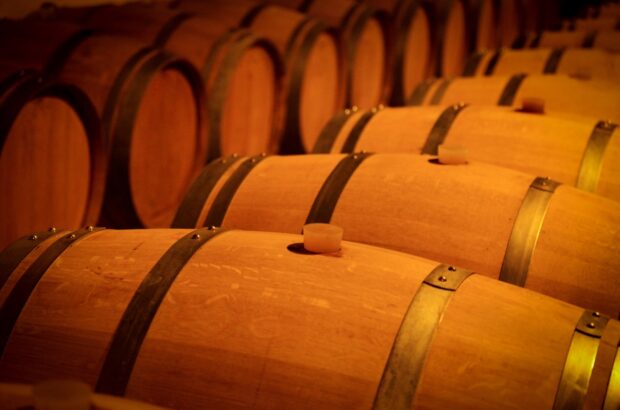Whisky has been made in England for longer than you might think. Distilleries in London, Bristol and Liverpool were operational as long ago as the 19th century – even if the spirits they created failed ever to gain the renown enjoyed by their rivals in Scotland and Ireland. But, when London’s Lea Valley Distillery fell silent in 1905, England vanished from the global whisky map for nearly a century.
The full-on renaissance we see now – there are currently roughly 40 distilleries making whisky the length and breadth of the country – took time to build momentum. Hicks & Healey ran spirit in Cornwall in 2003, but the first English whisky operation of any size was established by the Nelstrop farming family in Norfolk in 2006.
The English Whisky Company’s St George’s Distillery has a set-up that will be familiar to anyone who’s visited a malt distillery north of the border: copper pot stills built by Forsyths of Rothes and a process that, in general, follows the template of Scotch.
In general. St George’s produces plenty of traditional, double-distilled whisky from malted barley, but there’s an experimental edge that has since been emulated by many other English whisky-makers: triple-distilled malt, peated spirit runs and the exploration of alternative raw materials such as rye, wheat and oats, as well as chocolate and crystal malt.
East Anglia’s rolling arable fields offer a natural backdrop for making whisky. Throw in brewing expertise and it’s easy to understand why Adnams, located in the well-heeled Suffolk resort town of Southwold, should turn its hand to the craft.

Copper House Distillery. Credit: Anthony Cullen
Visit Adnams’ glass-fronted Copper House Distillery and you’re definitely not in Speyside any more… gleaming stills made by Christian Carl in Germany, and a dizzyingly tall beer stripping column. Since 2011, Adnams has been making whisky here, including a core range of Single Malt, Rye Malt (75/25 rye/barley) and Triple Malt (wheat, barley and oats).
St George’s and Adnams are roughly an hour’s drive apart when the traffic’s kind, but the contrasts between their styles of spirit are palpable. What unites them is their willingness to riff on traditional distillation techniques to probe new frontiers of flavour.
Explore English whisky beyond East Anglia and this sense of curiosity and diversity takes hold even more strongly. It’s best not to think about ‘English whisky’ in any generic sense – after all, would you do the same with Scotch? – and instead, rather as in Burgundy and other wine regions, focus on the qualities of the individual producer.
When Dan Szor established Cotswolds Distillery in Stourton in 2014, the whisky-loving ex-financier was inspired partly by Islay distillery Bruichladdich, with its focus on grain provenance and manual operation, but mainly by the countryside he saw around him. That quintessentially English pastoral landscape finds a sensory echo in Cotswolds’ lightly fruity, honeyed distillate.

Cotswolds Distillery
More than 200 miles north, Cumbria’s panoramas are, by comparison, rich and dramatic, with soaring summits and steeply plunging mountain dales. Here, in a converted Victorian dairy farm on the shores of Bassenthwaite Lake, The Lakes Distillery produces a hedonistically fruity, velvety spirit that finds its finest expression in a selection of ex-Sherry casks. At The Lakes, the choice of wood is every bit as vital as the character of the distillate.
Kent’s River Medway is about as far – geographically and visually – as you can get from the Lake District without leaving England altogether. And the same contrasts apply to the Copper Rivet Distillery set up by the Russell family in Chatham’s Royal Dockyard.
Experimentation and provenance walk hand-in-hand here, with a variety of cereal grains grown by local farmers and a Heath Robinson array of malts, stills and abv levels. It isn’t complete anarchy though: the distillery abides by a strict set of rules – the Invicta Charter – covering everything from age statements to permitted grains and provenance.
This raises an intriguing issue for the fast-developing English whisky industry: does it need a rulebook? Scotch is governed by a famously strict set of regulations enshrined in UK law, but whisky south of Hadrian’s Wall arguably owes much of its excitement and diversity to the freedom with which distilleries are permitted to operate.
Nonetheless, as English whisky continues to thrive and expand, producers have banded together to create the English Whisky Guild, announced in May this year. Its 15 founder members – including Adnams, Copper Rivet, Cotswolds, The English Whisky Co and The Lakes – have a vision of ‘showcasing and protecting the remarkable quality and diversity of the now numerous, unique whiskies that are crafted in England’.
Crucially, the EWG talks about diversity in the same breath as consistency of quality, and that combination is going to be vital if the industry is to fulfil the bullish growth projections offered by the Guild: spirit volume from English whisky distilleries is forecast to rise by 189% between 2019 and 2023, and the number of bottles sold could soar by 418% over the same timescale.
English whisky may be Scotch’s younger, smaller sibling, but it’s an increasingly noisy one and – much more importantly – it’s already bottling some terrific liquid.

The Lakes Distillery
Cotswolds Founder’s Choice Whisky
The late whisky guru Dr Jim Swan discovered that combining relatively youthful spirit with STR (shaved, toasted and recharred) ex-red wine barriques makes for an intensely juicy, luscious whisky. Bottled at cask strength, this is brimming with chocolate-coated plums, plus a cereal-accented, nutty note from Cotswolds’ light but characterful distillate.
Alc 59.1-60.5%.
The Lakes The Whiskymaker’s Reserve No 5 Single Malt
This seriously impressive distillery on the shores of Bassenthwaite Lake in Cumbria continues to evolve and hone its Sherry wood-led style, this time combining ex-oloroso, PX and red wine casks of Spanish and American oak. Explosively aromatic, the Sherried sweetness veers off into savoury – almost meaty – territory. A rich, indulgent whisky.
Alc 52%.
Masthouse Single Malt
Made at the Copper Rivet distillery in Chatham’s Royal Dockyard, this is an expressive whisky that aims to capture the character of locally grown Belgravia barley, matured in first-fill ex-Bourbon and virgin oak casks. Long fermentation brings flavours of hedgerow flowers, hothouse fruits, and a cereal note rounded out by oak-derived ginger and white chocolate.
Alc 45%.
The Norfolk Parched Single Grain
The ‘old timer’ of the English whisky scene still leads the pack thanks to a diverse family of whiskies and a ceaseless experimental zeal. This is a modern classic, offering a zesty lemon character, butterscotch and popcorn along with a touch of baking spices and persistent vanilla. Beautifully poised between the sweet and the dry.
Alc 45%.
The Oxford Artisan Distillery Rye Whisky Batch 4
Billed as ‘The Graduate’, this fourth TOAD rye release uses a mix of ‘maslin’ grains – heritage rye and wheat grown together locally and harvested in 2017 – and a combination of American oak casks of various sizes and toasts. That adds extra complexity to the distillery’s punchy rye style, including tangy forest fruits, a pinch of fiery chilli heat and, beneath it all, a drying cereal character.
Alc 51.3%.
Wire Works Single Malt First Release
Derbyshire’s debut whisky, made at the White Peak Distillery, a 19th-century former wire works on the banks of the River Derwent, is a hugely promising, lightly peated spirit full of orchard fruits, coffee cake and toffee from the use of ex-Bourbon and STR casks. The peat is relatively gentle, adding seasoning to a characterful spirit created using long fermentations and a unique yeast with links to the local brewing industry.
Alc 50.3%.







